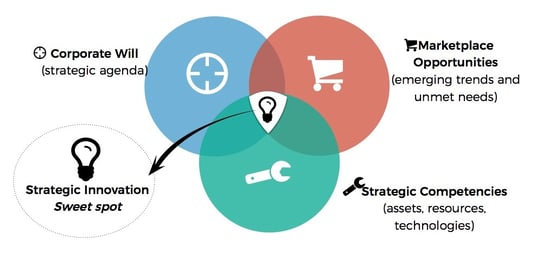 The other day I was having a conversation with the Division President of a large company about innovation. I mentioned to him that in our 30 years in the innovation space, we have noticed that innovation initiatives tend to have a 3-5 year life. The pursuit of breakthrough innovation – “Big Bet” innovation that expands the opportunity for significant growth through expanding markets or creating new ones, takes time. The unfortunate result of changes in Corporate Will is that too often, just when investments begin to pay off with new platforms, new technologies, etc., the efforts are often abandoned.
The other day I was having a conversation with the Division President of a large company about innovation. I mentioned to him that in our 30 years in the innovation space, we have noticed that innovation initiatives tend to have a 3-5 year life. The pursuit of breakthrough innovation – “Big Bet” innovation that expands the opportunity for significant growth through expanding markets or creating new ones, takes time. The unfortunate result of changes in Corporate Will is that too often, just when investments begin to pay off with new platforms, new technologies, etc., the efforts are often abandoned.
This observation has led us to look closely at what we call “Corporate Will.” Corporate Will includes Corporate Vision, Mission, and long-term Strategy, but adds the human layer to it. It’s not just what the company sets out to do, but what the individuals in positions of leadership and control actually want to do. It’s about an overlay of their personal/professional agendas, their particular comfort zones (based upon their experience and expertise), and frankly, what excites them. How they will make their mark.
Considering that there are many routes to achieving a particular strategy, Corporate Will is the driving factor for the decisions they make. You can easily “check off” the virtual evaluation “box” that says “Fits with our strategy” for any number of tactics. But choosing which one will actually get support, air cover and resources is a matter of “Corporate Will.”
Intrigued by the thought, and affirming that the concept was one of those “Blinding Glimpses of the Obvious” that he hadn’t thought about before, he added to our observation. His point was “It’s actually a bigger thought than just innovation efforts. It’s true of everything the company does.”
 While most executives involved with innovation or new product development cite as fact that “80% of new product introductions fail,” most are unaware that, 80% of initially resourced innovation initiatives are canceled or abandoned before they ever get a chance to succeed or fail in the market. This is especially true for “breakthrough” or ”Big Bet” innovation initiatives. The biggest reasons for that are directly related to “Corporate Will.”
While most executives involved with innovation or new product development cite as fact that “80% of new product introductions fail,” most are unaware that, 80% of initially resourced innovation initiatives are canceled or abandoned before they ever get a chance to succeed or fail in the market. This is especially true for “breakthrough” or ”Big Bet” innovation initiatives. The biggest reasons for that are directly related to “Corporate Will.”
- Management changes. People leave, new people take on the roles (cancelling old agendas, introducing new ones and redirecting resources)
- Management changes their mind (new priorities emerge, again changing direction and resource allocations)
- Senior leadership and middle management are not really aligned (Middle management is pursuing things that fit the strategy, but they do not understand the Corporate Will dynamic, and sooner or later find they are not in line with it and their initiatives are cancelled, or simply do not receive the resources they need to move forward).
The consequences are obvious:

- Lack of Vision
- Lack of Clarity
- Lack of Confidence
- Lack of Alignment
- Lack of Consistency
Regardless of which of the above is at play, the result is the same. Changing directions, and abandonment of initiatives which have already used up significant resources and in many cases, are on a solid path for success. In other words, they are not failures, they are abandoned, cancelled, allowed to wither on the vine because they are not in tune with/aligned with Corporate Will.
We have built a framework for thinking about innovation that incorporates this dynamic in determining the innovation “sweetspot.” Simply put, the only space where success can happen is where the three domains of Corporate Will, Unmet Marketplace Needs and Corporate Competencies intersect. Every other space in this Venn diagram is, in effect, “failure.”

It’s interesting to note that everyone from Sherlock Holmes to your local police  detective understands this basic paradigm. They call it “Means, Motive and Opportunity.” It’s a useful framework for thinking through many business initiatives. What is the opportunity? Do we have the means or competencies to achieve it, and do we really want to do it (Motive)?
detective understands this basic paradigm. They call it “Means, Motive and Opportunity.” It’s a useful framework for thinking through many business initiatives. What is the opportunity? Do we have the means or competencies to achieve it, and do we really want to do it (Motive)?
Interesting Jay, but “What’s the point?” There are several.
- No one is truly “empowered” or “enabled” unless they are aligned. To be aligned, you must understand the principle of “Corporate Will” with key stakeholders communicating clearly and regularly over time. Too often we hear from even fairly high-level executives “I’ve been empowered/ assigned/given the responsibility to do this, we don’t need to discuss it with those above me.” For initiatives that are going to require significant investment of resources, time, etc., get a third party involved in the early stages of direction-setting between all key stakeholders. Third parties listen differently, more objectively and can help ask the “dumb” questions that ensure clarity of meaning.
- Top, Senior leaders need to be aligned around strategic priorities, and on guard for the inevitable swings of the pendulum as key players change or business factors arise
- The Board of Directors should have a role in managing Corporate Will. Employees and executives change. Changes in Corporate Will should have a long-term view in mind and not be subject to the whims of changing individuals.
In a World of Volatility, Uncertainty, Complexity and Ambiguity, leaders must have Vision, understanding, Clarity, and Agility… we would suggest that for long-term Strategy, Consistency and Commitment are critical to effective “Corporate Will.”




